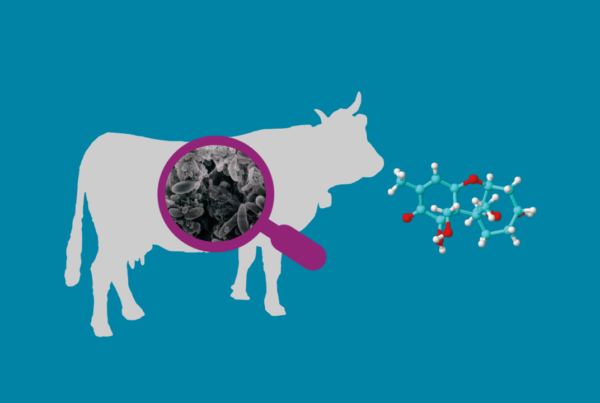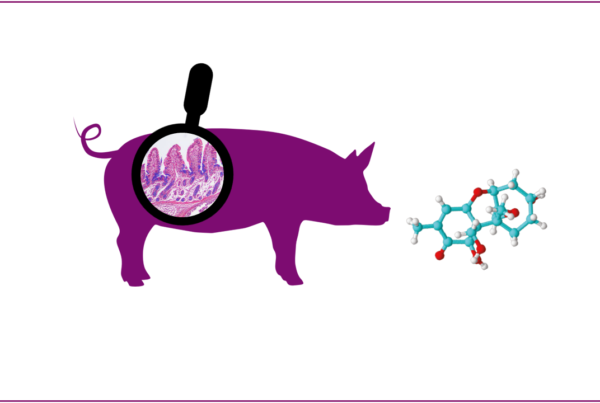New scientific article on DigestSea®.
Algae are currently a hot topic due to their nutritional, structural and biological properties as well as for their sustainability and ecosystems services. For over 20 years, Olmix has developed solutions for animal, vegetal and human care based on marine biotechnology. Olmix has specialized in the identification, characterization and extraction of specific MSP® (Algae Sulfated Polysaccharides) from green, red and brown marine algae. Among them, an MSP® extract with anti-hyperlipidemic properties was identified. It is now being used in poultry production for its capacity to stimulate digestion and avoid liver troubles, thanks to its action on the bile acid cycle and lipid metabolism for the benefit of performance.
Digestive system & liver, key organs in poultry breeders
The demand for rapid growth, high nutrient intake and high metabolic rate in poultry breeders can lead to metabolic disorders such as steatosis, a pathological intracellular overload of triglycerides. Therefore, it is essential to support lipid metabolism of poultry breeders to maintain good health and performance.
Sulfated polysaccharides, the treasures of macroalgae
The last 20 years, Olmix has focused on biological activities of seaweed polysaccharides, namely the MSP® (Algae Sulfated Polysaccharides).The specificity of MSP® stands in the complexity of their structure (Figure 1). Indeed, MSP® are branched hetero-polysaccharides, meaning that they have a three dimensional structure and are composed of various sugar units (including rare ones like rhamnose). Moreover, these sugars can be sulfated, conferring them a special reactivity. All these parameters show a structural similarity with polysaccharides from the animal kingdom (such as heparin), explaining MSP®s unique biological activities. Several MSP® with distinct biological activities can be found in algae (among others immune-modulating, antioxidant and stimulating intestinal mucin production).
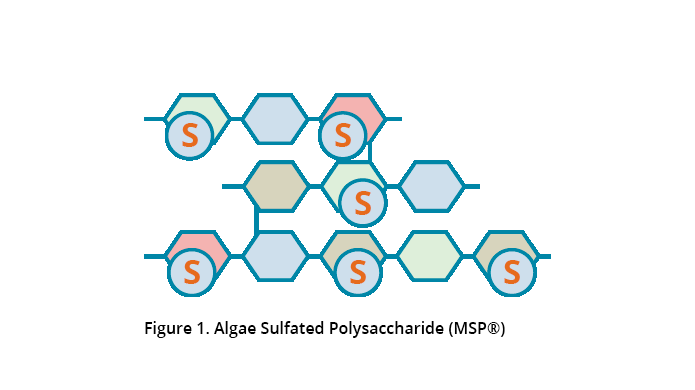
Specific MSP® to improve lipids metabolism
Several scientific publications have shown that some MSP®s have a direct impact on liver functioning through the regulation of the cycle of bile acids and the lipid metabolism.
This was first evidenced by Pengzhan et al. (2003), and highlighted the capacity of ulvans (sulfated polysaccharides from green algae Ulva sp) to lower the level of liver pathologies in animals fed high lipid diets (Figure 2). Qi et al. (2011, 2012) monitored the lipid profile of animals fed a hyperlipidemic diet and proved that the supplementation with ulvans significantly decreased TG, TC and LDL levels while increasing HDL level. In 2015, Qi et al. further demonstrated that this could be linked with an upregulation of some receptors by the algae extract, also pointing out that all ulvans do not have the same capacity to regulate hyperlipidemia.
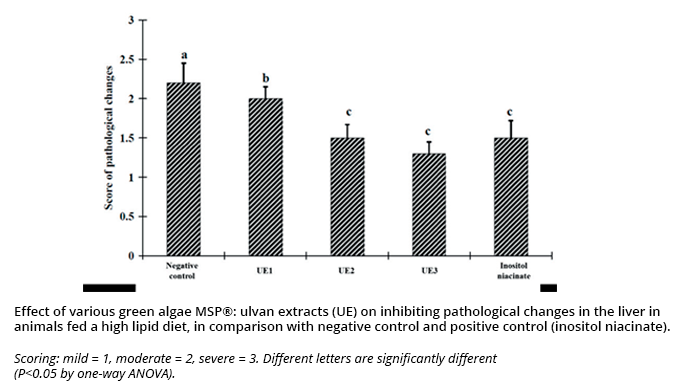
Hassan et al. (2011) also demonstrated an improvement of the lipid profile in animals supplemented with Ulva lactuca polysaccharides. The mode of action seem to be linked to a better antioxidant capacity of the liver. In the end, it seems that ulvans have an important capacity to regulate lipid metabolism and bile acids cycle on one hand, and to activate detoxifying enzymes on the other hand.
MSP®LIPIDS, the backbone of DigestSea® the solution to better manage breeders performance
Based on this, Olmix has worked on the identification of a specific MSP® with enhanced antihyperlipidemic properties: MSP®LIPID, the backbone of Olmix feed complement DigestSea®. DigestSea® is formulated to stimulate the liver, thanks to the above-mentioned mechanism, and also contain plant extracts that support kidney activity and draining.
A trial was performed in two buildings of 2 000 breeders each, during the last five weeks of egg production. The Control group received a choline and sorbitol complex at 1L /1000L of drinking water while the Test group received DigestSea® at the dosage of 0.5L/1000L of drinking water. Histological evaluation of the liver was performed on 20 breeders from each group at the end of the trial. Portal area and blood capillaries integrity was rated using a scale from 0 to 4 accounting respectively for mild to severe damage.
Results (figure 3) showed a significant reduction of the biliary canal hyperplasia and the leukocytosis of the blood capillaries present in the portal area (P<0.01) in the Test group compared to the Control group. Hyperplasia is an abnormal cellular growth leading to a reduction in the luminal space of the bile duct. It impairs the bile excretion. The decrease of the biliary canal hyperplasia in the group which received the DigestSea® allow for increased biliary excretion and a lower reabsorption of bile acids in the intestine. Moreover, leukocytosis and congestion in capillaries were lower in the test group, reflecting a higher blood flow, and thus a better irrigation of the liver. This increased blood flow is likely to improve the hepatic exchange for both nutrients and toxins. These improvements of the hepatic function in the test group reflect an improved lipid metabolism and lead to better performance of the breeders.
Liver sections in the Figure 4 show a homogeneous and decreased size of lipid vacuoles in the Test group (b) compared to Control (a).
The continued monthly use of DigestSea® in this farm after the trial confirmed the capacity of the product to improve digestive performance of the breeders and to prevent liver troubles, as shown by the globally increased laying performance of the breeders and productivity of the farm (figure 5).
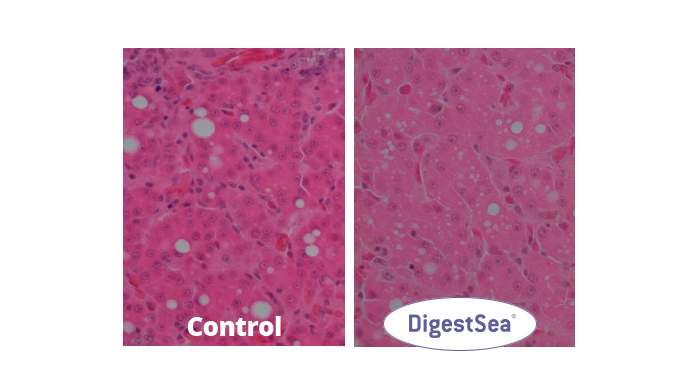
Figure 4.
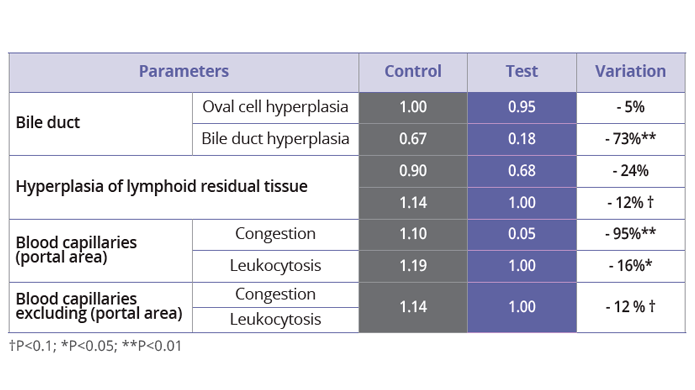
Figure 5.
Conclusion
With its unique composition based on MSP®LIPIDS, DigestSea® has a positive effect on the digestion process and can be used effectively in poultry production to prevent the occurrence of liver troubles, or a decrease in feed intake and egg production during high metabolic periods. All the results are published in the journal of US-China Medical Science 17 (2020).
